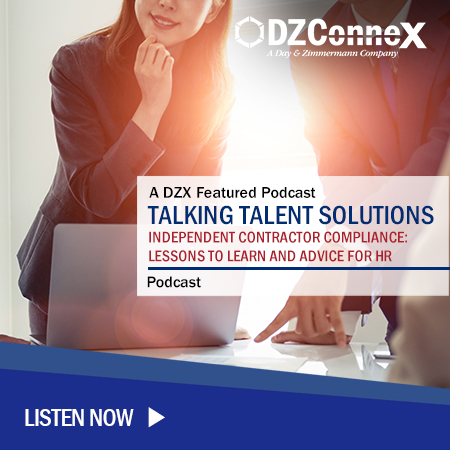Did you know that making the mistake of misclassifying your workforce can cost your organization millions of dollars?
Accurately classifying employees and contingent workers within your workforce is a critical responsibility for organizations of every size. Failing to classify workers correctly can result in severe legal and financial consequences that can take a toll on your organization. The recent news regarding Nike potentially facing a staggering $530 million fine for worker misclassification, according to documents obtained by The Guardian, is a stark reminder of the importance of getting it right.
In this episode of our Talking Talent Solutions podcast series, we, and our host, Joe McIntyre, discuss the importance of independent contractor (IC) vetting, lessons to learn and advice for HR.
Listen to our Podcast:
Independent Contractors (ICs) vs. W2 Employees: Understanding the Difference
In order to classify workers correctly, it’s crucial to understand the distinctions between Independent Contractors (ICs) and W2 employees.
Independent Contractors are individuals who operate as their own businesses and are responsible for managing their own taxes, benefits, and legal obligations. They typically work on a project-to-project basis, have more control over their work, and usually provide their own tools and equipment. On the other hand, W2 employees are traditional employees who work under the direction and control of their employer. These employees receive benefits and have their taxes withheld. Each option has its advantages and disadvantages. For instance, collaborating with in-house staff grants managers increased control over the project's workflow and processes, while opting for a contingent workforce provides greater staffing flexibility.
The Implications of Misclassifying Workers
Misclassifying workers can lead to significant legal and financial consequences that can be difficult to come back from. Consequently, legislation has emerged to help distinguish between employees and ICs, and navigating these classifications can be quite challenging. When workers are misclassified as ICs instead of W2 employees, businesses may be required to pay backed payroll taxes, overtime compensation, workers' compensation insurance, and other benefits offered to full-time W2 employees. This can result in, not only financial implications, but can also harm employee morale, damage a company's reputation, and erode trust between workers and the organization.
IC Vetting and Ensuring Compliance Within Your Workforce
Proper steps to avoid worker misclassification should always be a priority and should never be skipped. Your organization should be having regular and thorough internal audits, worker classification education materials for HR, payroll and any other department that manages your workforce data, and training on worker classification laws. An IC Vetting Program should be part of this process as well in order to ensure compliance. An IC Vetting Program is a comprehensive process used to carefully evaluate and validate the classification of independent contractors to reduce risk. It involves a systematic review of a worker status, considering factors such as,
• The degree of control over their work
• The nature of their relationship with the company
• Their level of independence
Establishing a successful IC vetting program requires a collaboration between HR, legal and compliance teams. Every organization should consult with legal experts to ensure they are within proper employment laws and regulations, develop consistent criteria to determine your worker’s classification, and potentially invest in technology to streamline the vetting process. This where a Total Talent expert, such as DZConneX, comes in.
Introducing DZConneX's Solution for Accurate Classification
At DZConneX, we recognize the complexities of worker classification and have developed a proprietary system designed to streamline the process. Our proprietary IC vetting, along with our dedicated IC vetting group, provides a comprehensive framework that considers relevant legal requirements, industry best practices, and the unique dynamics of your workforce environment, along with ABC testing.
What is ABC Testing?
ABC testing considers the following three factors,
- The control that the company exerts on the worker.
- Whether the work is outside the company's typical business.
- Whether the worker normally provides this type of work as an independent business.
ABC testing is complex and can vary down to the county level however by leveraging our innovative technology, businesses can ensure accurate worker classification, maintain compliance with legal requirements, and enhance operational efficiency.
We understand that every organization's workforce has different challenges and needs, which means that our solutions are completely customizable and uniquely configured to fit your needs. We expertly manage all your IC, contingent labor needs, and talent supply chain. Our dedicated workforce solutions and program management team can help solve even your most challenging problems with our proprietary technology and innovative approach to total talent solutions. Ultimately, this takes the burden off your organization.
Accurate worker classification is paramount to avoid costly mistakes and legal liabilities. By understanding the differences between Independent Contractors and W2 employees, businesses can ensure compliance, protect their financial interests, and maintain positive relationships with their workforce. Don't underestimate the importance of proper worker classification—start prioritizing it today to safeguard your business.
To listen to the full podcast, gain additional expert insights, and learn what DZConneX's dedicated Total Talent teams can do for your organization, listen to the podcast here.







